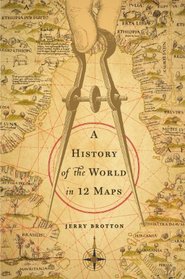Reviewed first published on my blog: http://memoriesfrombooks.blogspot.com/2013/12/a-history-of-world-in-12-maps.html
A History of the World in 12 Maps starts with Ptolemy's Geography dated from the second century and ends with the current version of Google Earth. The other maps included in the 12 are:
- 1100s - the maps of Muhammad al-Idrisi created for the king of Sicily
- Circa 1300 - the Mappamundi created in Italy
- 1402 - Kangnido world map from Japan, one of the oldest surviving maps of East Asia
- 1507 - German cartographer Martin Waldseemuller's world map credited with the first usage of the word America
- 1529 - Diogo Ribeiro 1529 credited to be first scientific world map
- 1569 - Belgian Gerard Mercator's map that used a navigational grid
- 1600 - Joan Baleu's creation of an atlas in Amsterdam
- 1700s - Maps of France by the Cassini family, the first to use triangular measurements
- Early 1900s - maps by Halford Mackinder, the first to address geopolitical maps
- 1970s - Peters Projection named for German historian Arno Peters
As this list shows, the book is literally a walk forward through history. It covers a length and breadth of the Eurocentric world as it was known at the time. It also presents a history of cartography with its technical and usage innovations. In addition, it presents the history of the time, place, and people behind the map - clearly and repeatedly making the point that a map reflects the interpretation and vision of the mapmakers.
This book is dense. It contains a lot of information - on the maps themselves and on the geopolitical climate and events that led to the development of each map. As such, it becomes a history of cartography and a history of the world. At the same time, it is a very enjoyable and readable book. A great pick for anyone who enjoys history or geography.
*** Reviewed based on a ebook galley received through NetGalley ***
A History of the World in 12 Maps starts with Ptolemy's Geography dated from the second century and ends with the current version of Google Earth. The other maps included in the 12 are:
- 1100s - the maps of Muhammad al-Idrisi created for the king of Sicily
- Circa 1300 - the Mappamundi created in Italy
- 1402 - Kangnido world map from Japan, one of the oldest surviving maps of East Asia
- 1507 - German cartographer Martin Waldseemuller's world map credited with the first usage of the word America
- 1529 - Diogo Ribeiro 1529 credited to be first scientific world map
- 1569 - Belgian Gerard Mercator's map that used a navigational grid
- 1600 - Joan Baleu's creation of an atlas in Amsterdam
- 1700s - Maps of France by the Cassini family, the first to use triangular measurements
- Early 1900s - maps by Halford Mackinder, the first to address geopolitical maps
- 1970s - Peters Projection named for German historian Arno Peters
As this list shows, the book is literally a walk forward through history. It covers a length and breadth of the Eurocentric world as it was known at the time. It also presents a history of cartography with its technical and usage innovations. In addition, it presents the history of the time, place, and people behind the map - clearly and repeatedly making the point that a map reflects the interpretation and vision of the mapmakers.
This book is dense. It contains a lot of information - on the maps themselves and on the geopolitical climate and events that led to the development of each map. As such, it becomes a history of cartography and a history of the world. At the same time, it is a very enjoyable and readable book. A great pick for anyone who enjoys history or geography.
*** Reviewed based on a ebook galley received through NetGalley ***




